Investment and Profitability of Community Heating Systems Using Bioenergy in Finland: Opportunities and Challenges
Abstract
:1. Introduction
1.1. Background
1.2. Portable Heat Containers as a Solution
2. Materials and Methods
2.1. Background
2.2. Fuel
- s is the stumpage price,
- l is the logging price,
- f is the forwarding price,
- p is the piling price,
- ct is chipping at the terminal,
- d is the driver’s salary, and
- fc is the fuel cost.
2.3. Cost Calculation
- I is investment costs
- i is interest rate
- t is lifetime in years (20)
- Ct is the net cash flow at the end of year t,
- I0 is the initial investment,
- k is the discount rate, and
- t is the lifetime in years (20).
2.4. Sensitivity Analysis
2.5. The Origin of the Chips and Chipping Method
3. Results
3.1. Sensitivity Analysis
3.1.1. Housing Association Point of View
3.1.2. Different Variables
3.1.3. The Price of Chips and Its Impact
4. Discussions
4.1. Drivers for the Energy Transition
4.2. Opportunities for the Local Economy
4.3. Barriers for Investments
5. Conclusions
Author Contributions
Funding
Conflicts of Interest
References
- IPCC. Global Warming of 1.5 °C. An IPCC Special Report on the Impacts of Global Warming of 1.5 °C above Pre-Industrial Levels and Related Global Greenhouse Gas Emission Pathways, in the Context of Strengthening the Global Response to the Threat of Climate Change, Sustainable Development, and Efforts to Eradicate Poverty; Masson-Delmotte, V., Zhai, P., Pörtner, H.-O., Roberts, D., Skea, J., Shukla, P.R., Pirani, A., Moufouma-Okia, W., Péan, C., Pidcock, R., et al., Eds.; IPCC: Geneva, Switzerland, 2018. [Google Scholar]
- Carbon Neutral Finland. 2021. Objective 1: Finland Will Achieve Carbon Neutrality by 2035. Available online: https://valtioneuvosto.fi/en/marin/government-programme/strategic-themes (accessed on 19 April 2021).
- Cross, S.; Welfle, A.J.; Thornley, P.; Syri, S.; Mikaelsson, M. Bioenergy development in the UK & Nordic countries: A comparison of effectiveness of support policies for sustainable development of the bioenergy sector. Biomass Bioenergy 2021, 144, 105887. [Google Scholar]
- Statistics of Finland. Total Energy Consumption by Energy Source (All Categories), 1970–2020. Available online: https://pxnet2.stat.fi/PXWeb/pxweb/en/StatFin/StatFin__ene__ehk/statfin_ehk_pxt_12vq.px/ (accessed on 20 August 2021).
- Statistics of Finland. Final Energy Consumption by Sector, 1970–2020*. Available online: https://pxnet2.stat.fi/PXWeb/pxweb/en/StatFin/StatFin__ene__ehk/statfin_ehk_pxt_12vk.px/ (accessed on 20 August 2021).
- Lindroos, T.J.; Mäki, E.; Koponen, K.; Hannula, I.; Kiviluoma, J.; Raitila, J. Replacing fossil fuels with bioenergy in district heating–Comparison of technology options. Energy 2021, 231, 120799. [Google Scholar] [CrossRef]
- Rikkonen, P.; Tapio, P.; Rintamäki, H. Visions for small-scale renewable energy production on Finnish farms—A Delphi study on the opportunities for new business. Energy Policy 2019, 129, 939–948. [Google Scholar] [CrossRef]
- Statistics of Finland. Heating System. 2021. Available online: https://www.stat.fi/meta/kas/lam_tapa_en.html (accessed on 11 August 2021).
- Official Statistics of Finland (OSF): Energy Consumption in Households. ISSN=2323-329X. 2019, Appendix Table 2. Energy Consumption in Households by Energy Source in 2019, GWh. Helsinki: Statistics Finland. Available online: http://www.stat.fi/til/asen/2019/asen_2019_2020-11-19_tau_002_en.html (accessed on 11 August 2021).
- Hast, A.; Ekholm, T.; Syri, S. What is needed to phase out residential oil heating in Finnish single-family houses? Sustain. Cities Soc. 2016, 22, 49–62. [Google Scholar] [CrossRef]
- DIN EN 303-5. European Standard. Available online: https://www.en-standard.eu/din-en-303-5-heating-boilers-part-5-heating-boilers-for-solid-fuels-manually-and-automatically-stoked-nominal-heat-output-of-up-to-500-kw-terminology-requirements-testing-and-marking/ (accessed on 11 August 2021).
- Biofire. Hakelämpö-Kontti Integroidulla Varastolla—Teholuokat 60–500 kW. 2021. Available online: https://www.biofire.fi/hakelampokontti/ (accessed on 1 June 2020).
- Föhr, J.; KC, R.; Ranta, T.; Miettinen, M. Hydraulically Powered Wood Chip Blower in Test and Its Use Opportunity in Biofuel Supply Chain. J. Sustain. Bioenergy Syst. 2020, 10, 77–91. [Google Scholar] [CrossRef]
- Lehtonen, O.; Okkonen, L. Energy cost reduction creates additional socioeconomic benefits—The case of Eno Energy Cooperative, Finland. Energy Policy 2019, 129, 352–359. [Google Scholar] [CrossRef]
- Anca-Couce, A.; Hochenauer, C.; Scharler, R. Bioenergy technologies, uses, market and future trends with Austria as a case study. Renew. Sustain. Energy Rev. 2021, 135, 110237. [Google Scholar] [CrossRef]
- Young, J.D.; Anderson, N.M.; Naughton, H.T. Influence of policy, air quality, and local attitudes toward renewable energy on the adoption of woody biomass heating systems. Energies 2018, 11, 2873. [Google Scholar] [CrossRef] [Green Version]
- Hendricks, A.M.; Wagner, J.E.; Volk, T.A.; Newman, D.H.; Brown, T.R. A cost-effective evaluation of biomass district heating in rural communities. Appl. Energy 2016, 162, 561–569. [Google Scholar] [CrossRef]
- Hess, D.J.; Sovacool, B.K. Sociotechnical matters: Reviewing and integrating science and technology studies with energy social science. Energy Res. Soc. Sci. 2020, 65, 101462. [Google Scholar] [CrossRef]
- Peltola, T. Energy Policy or Forest Policy or Rural Policy? Transition from Fossil to Bioenergy in Finnish Local Heating Systems. In Energy, Policy, and the Environment. Studies in Human Ecology and Adaptation; Järvelä, M., Juhola, S., Eds.; Springer: New York, NY, USA, 2011; Volume 6, pp. 155–171. [Google Scholar]
- Komendantova, N. Transferring awareness into action: A meta-analysis of the behavioral drivers of energy transitions in Germany, Austria, Finland, Morocco, Jordan and Iran. Energy Res. Soc. Sci. 2021, 71, 101826. [Google Scholar] [CrossRef]
- Official Statistics of Finland (OSF): Producer Price Indices. ISSN=1799-3695. February 2021, Appendix Table 25. Wood Pellet, Consumer Price. Helsinki: Statistics Finland. Available online: http://www.stat.fi/til/thi/2021/02/thi_2021_02_2021-03-24_tau_025_en.html (accessed on 10 August 2021).
- Official Statistics of Finland. Consumer Price of Liquid Fuel (VAT Included). 2021. Statistics Finland’s Free-of-Charge Statistical Databases. Helsinki. Available online: https://pxnet2.stat.fi/PXWeb/pxweb/en/StatFin/StatFin__ene__ehi/statfin_ehi_pxt_12ge.px/ (accessed on 23 June 2021).
- Engineering ToolBox, Fuels—Higher and Lower Calorific Values. Available online: https://www.engineeringtoolbox.com/fuels-higher-calorific-values-d_169.html (accessed on 9 September 2021).
- Miettinen, M.; Lämpösi Oy, Jyväskylä, Finland. Personal communication, 2021.
- Alakangas, E.; Hurskainen, M.; Laatikainen-Luntama, J.; Korhonen, J. Suomessa Käytettävien Polttoaineiden Ominaisuuksia; VTT TECHNOLOGY 258; VTT Technical Research Centre of Finland: Espoo, Finland, 2000; ISBN 9789513884192. [Google Scholar]
- LUKE. Volumes and Prices in Industrial Roundwood Trade. 2021. Available online: https://stat.luke.fi/en/volumes-and-prices-roundwood-trade (accessed on 21 June 2021).
- Karttunen, K.; Laitila, J. Forest management regime options for integrated small-diameter wood harvesting and supply chain from young Scots pine (Pinus sylvestris L.) stands. Int. J. For. Eng. 2015, 26, 124–138. [Google Scholar]
- Laitila, J.; Väätäinen, K. Truck transportation and chipping productivity of whole trees and delimbed energy wood in Finland. Croat. J. For. Eng. 2012, 33, 199–210. [Google Scholar]
- Obernberger, I.; Thek, G. The Pellet Handbook: The Production and Thermal Utilisation of Pellets; Routledge: Abingdon, UK, 2010; p. 241. [Google Scholar]
- Jormakka, R.; Koivusalo, K.; Lappalainen, J.; Niskanen, M. Laskentatoimi [Accounting]; Edita: Helsinki, Finand, 2009; p. 234. ISBN 9789513764784. [Google Scholar]
- Official Statistics of Finland (OSF): Dwellings and Housing Conditions. ISSN=1798-6761. Overview 2019, 2. Household-Dwelling Units and Housing Conditions 2019. Helsinki: Statistics Finland. Available online: http://www.stat.fi/til/asas/2019/01/asas_2019_01_2020-10-14_kat_002_en.html (accessed on 8 October 2021).
- Official Statistics of Finland (OSF): Energy Consumption in Households. ISSN=2323-329X. Helsinki: Statistics Finland. Available online: https://pxnet2.stat.fi/PXWeb/pxweb/en/StatFin/StatFin__ene__asen/statfin_asen_pxt_11zr.px/table/tableViewLayout1/ (accessed on 11 October 2021).
- Official Statistics of Finland (OSF): Production of Electricity and Heat. ISSN=1798-5099. Helsinki: Statistics Finland. Available online: https://pxnet2.stat.fi/PXWeb/pxweb/en/StatFin/StatFin__ene__salatuo/statfin_salatuo_pxt_12b7.px/ (accessed on 8 October 2021).
- Statistics: Energy Prices. ISSN=1799-800X. 1st Quarter 2021, Appendix Table 3. Consumer Prices of Heating Energy in March 2021. Helsinki: Statistics Finland. Available online: http://www.stat.fi/til/ehi/2021/01/ehi_2021_01_2021-06-10_tau_003_en.html (accessed on 12 August 2021).
- Madlener, R. Innovation diffusion, public policy, and local initiative: The case of wood-fuelled district heating systems in Austria. Energy Policy 2007, 35, 1992–2008. [Google Scholar] [CrossRef]
- Ruggiero, S.; Varho, V.; Rikkonen, P. Transition to distributed energy generation in Finland: Prospects and barriers. Energy Policy 2015, 86, 433–443. [Google Scholar] [CrossRef]
- ELY 2021. To Those Who Want to Change Oil Heating System. Available online: https://www.ely-keskus.fi/oljylammityksen-vaihtajalle (accessed on 21 April 2021).
- Hendricks, A.M.; Wagner, J.E.; Volk, T.A.; Newman, D.H. Regional economic impacts of biomass district heating in rural New York. Biomass Bioenergy 2016, 88, 1–9. [Google Scholar] [CrossRef]
- Madlener, R.; Koller, M. Economic and CO2 mitigation impacts of promoting biomass heating systems: An input–output study for Vorarlberg, Austria. Energy Policy 2007, 35, 6021–6035. [Google Scholar] [CrossRef]
- Soltero, V.M.; Chacartegui, R.; Ortiz, C.; Velázquez, R. Potential of biomass district heating systems in rural areas. Energy 2018, 156, 132–143. [Google Scholar] [CrossRef]
- Ruggiero, S.; Martiskainen, M.; Onkila, T. Understanding the scaling-up of community energy niches through strategic niche management theory: Insights from Finland. J. Clean. Prod. 2018, 170, 581–590. [Google Scholar] [CrossRef]
- Huttunen, S. Stakeholder frames in the making of forest bioenergy legislation in Finland. Geoforum 2014, 53, 63–73. [Google Scholar] [CrossRef]
- Nissinen, A.; Heiskanen, E.; Perrels, A.; Berghäll, E.; Liesimaa, V.; Mattinen, M. Combinations of policy instruments to decrease the climate impacts of housing, passenger transport and food in Finland. J. Clean. Prod. 2014, 107, 455–466. [Google Scholar] [CrossRef]
- Winquist, E.; Rikkonen, P.; Pyysiäinen, J.; Varho, V. Is biogas an energy or a sustainability product?—Business opportunities in the Finnish biogas branch. J. Clean. Prod. 2019, 233, 1344–1354. [Google Scholar] [CrossRef]
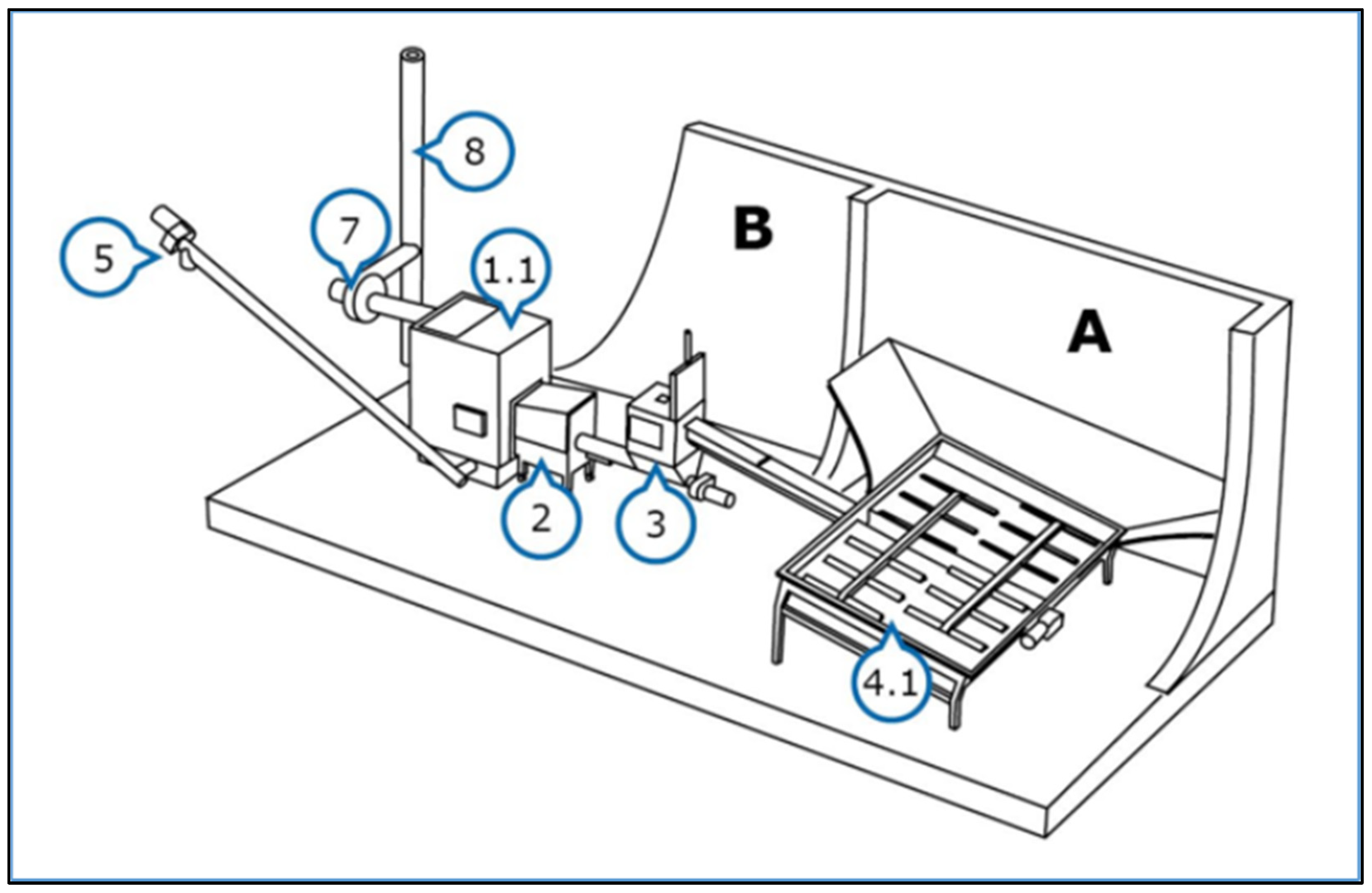
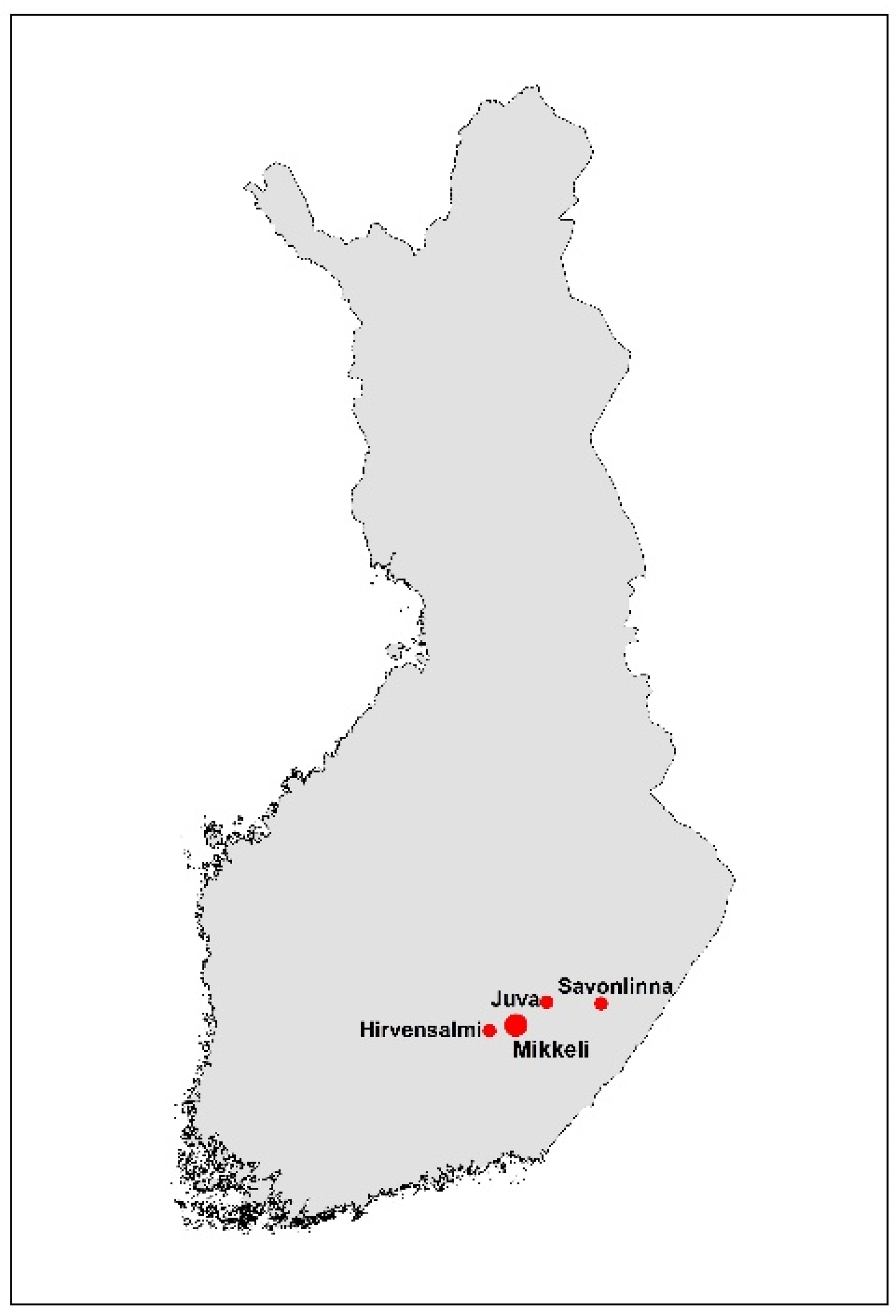
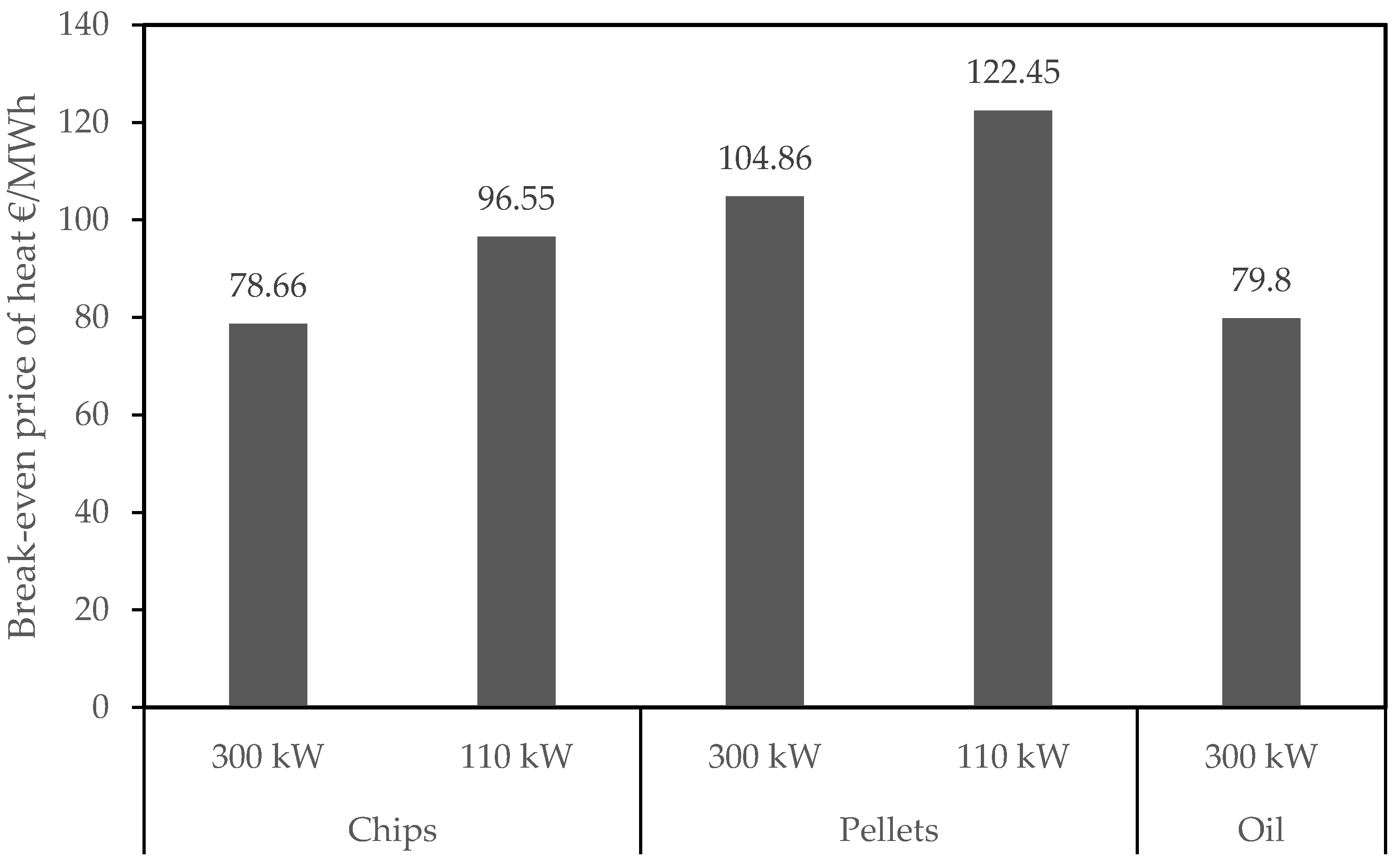

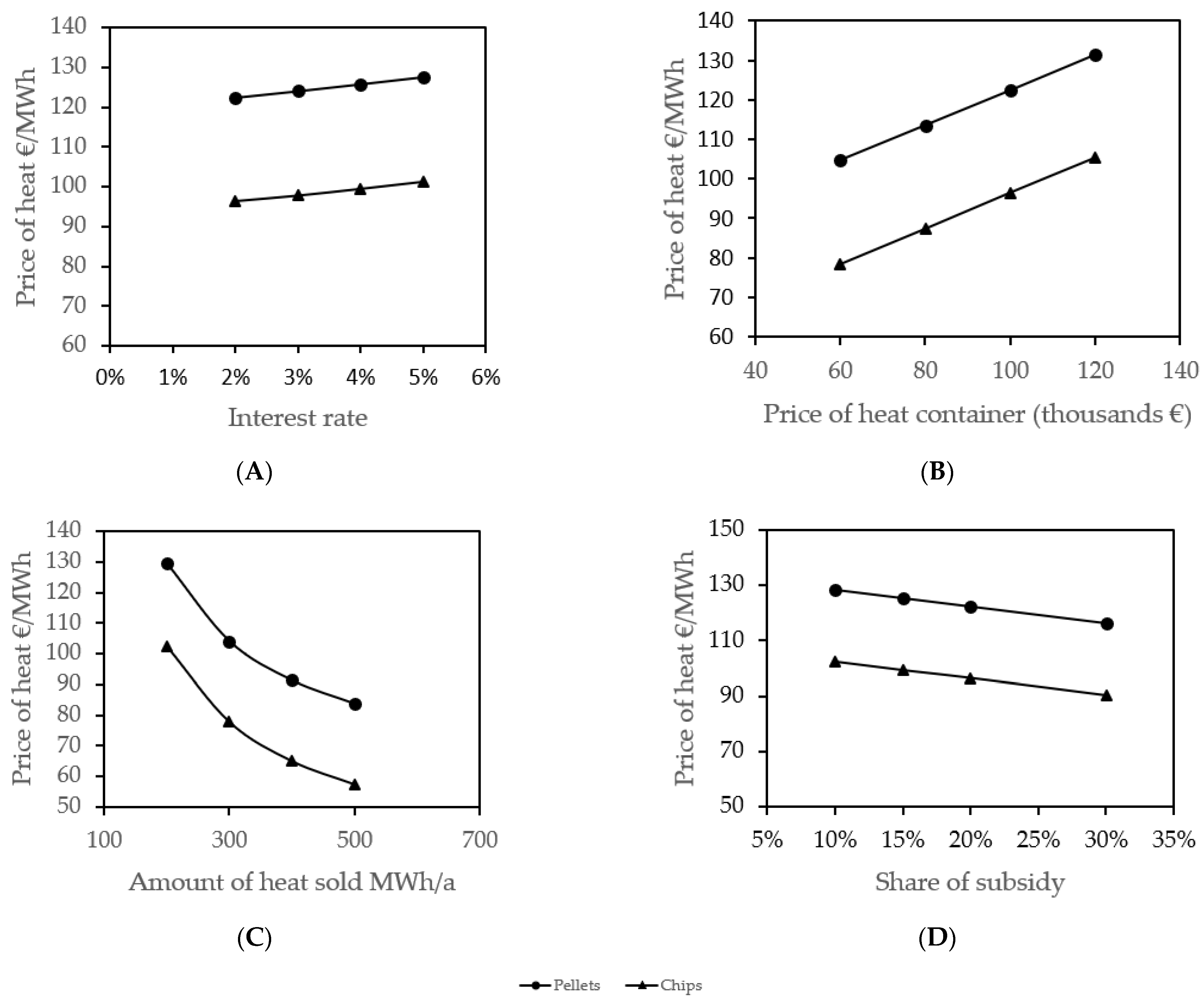
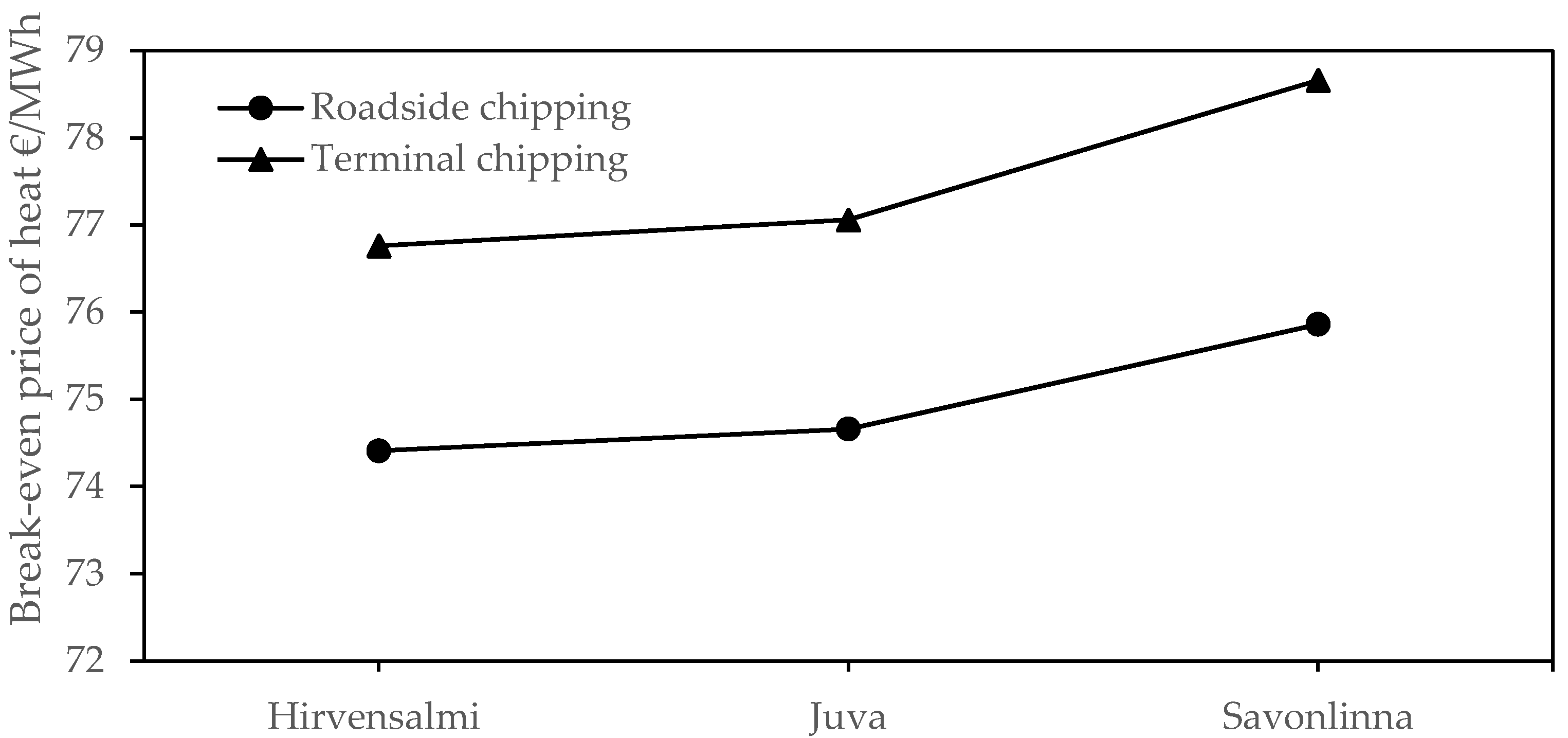
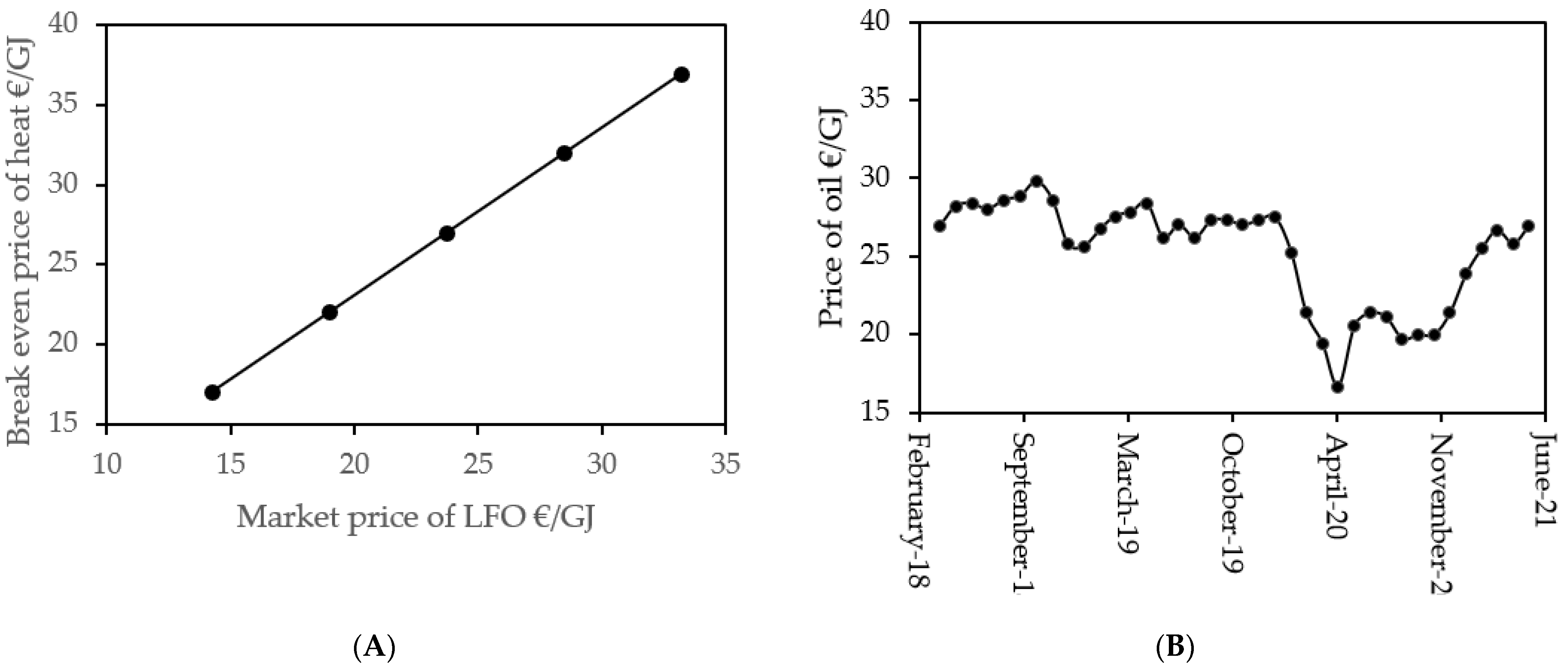
| Categories | Unit | Chips | Pellets | BAU | ||
|---|---|---|---|---|---|---|
| Nominal power | kW | 110 | 300 | 110 | 300 | 300 |
| Efficiency | % | 91 | 91 | 91 | 91 | 95 |
| Uptime | h/year | 2000 | 2000 | 2000 | 2000 | 2000 |
| Heat demand | MWh/a | 220 | 600 | 220 | 600 | 600 |
| Fuel price | €/GJ (HHV) | 6.12 1 | 6.02 1 | 13.17 2 | 13.17 2 | 19.08 3 |
| Annual Own energy cost 4 | € | 264 | 724 | 264 | 724 | |
| Capital investment 5 | ||||||
| Base construction | € | 7000 | 7000 | 7000 | 7000 | 1000 |
| Equipment cost | € | 100,000 | 200,000 | 100,000 | 200,000 | 15,000 |
| Other administrative costs | € | 1000 | 8000 | 1000 | 8000 | 1000 |
| Support | % | 20 | 20 | 20 | 20 | 0 |
| Price of Chips | Hirvensalmi | Juva | Savonlinna | |||
|---|---|---|---|---|---|---|
| HR | HT | JR | JT | SR | ST | |
| €/MWh | 18.41 | 20.37 | 18.64 | 20.65 | 19.67 | 22.03 |
| Energy Type | Prices in €/MWh (Excluding VAT) |
|---|---|
| LFO | 77.34 |
| Household electricity | 114.92 |
| Pellets | 47.42 |
| District heating | 67.41 |
Publisher’s Note: MDPI stays neutral with regard to jurisdictional claims in published maps and institutional affiliations. |
© 2021 by the authors. Licensee MDPI, Basel, Switzerland. This article is an open access article distributed under the terms and conditions of the Creative Commons Attribution (CC BY) license (https://creativecommons.org/licenses/by/4.0/).
Share and Cite
KC, R.; Föhr, J.; Gyawali, A.; Ranta, T. Investment and Profitability of Community Heating Systems Using Bioenergy in Finland: Opportunities and Challenges. Sustainability 2021, 13, 11757. https://doi.org/10.3390/su132111757
KC R, Föhr J, Gyawali A, Ranta T. Investment and Profitability of Community Heating Systems Using Bioenergy in Finland: Opportunities and Challenges. Sustainability. 2021; 13(21):11757. https://doi.org/10.3390/su132111757
Chicago/Turabian StyleKC, Raghu, Jarno Föhr, Arun Gyawali, and Tapio Ranta. 2021. "Investment and Profitability of Community Heating Systems Using Bioenergy in Finland: Opportunities and Challenges" Sustainability 13, no. 21: 11757. https://doi.org/10.3390/su132111757
APA StyleKC, R., Föhr, J., Gyawali, A., & Ranta, T. (2021). Investment and Profitability of Community Heating Systems Using Bioenergy in Finland: Opportunities and Challenges. Sustainability, 13(21), 11757. https://doi.org/10.3390/su132111757









